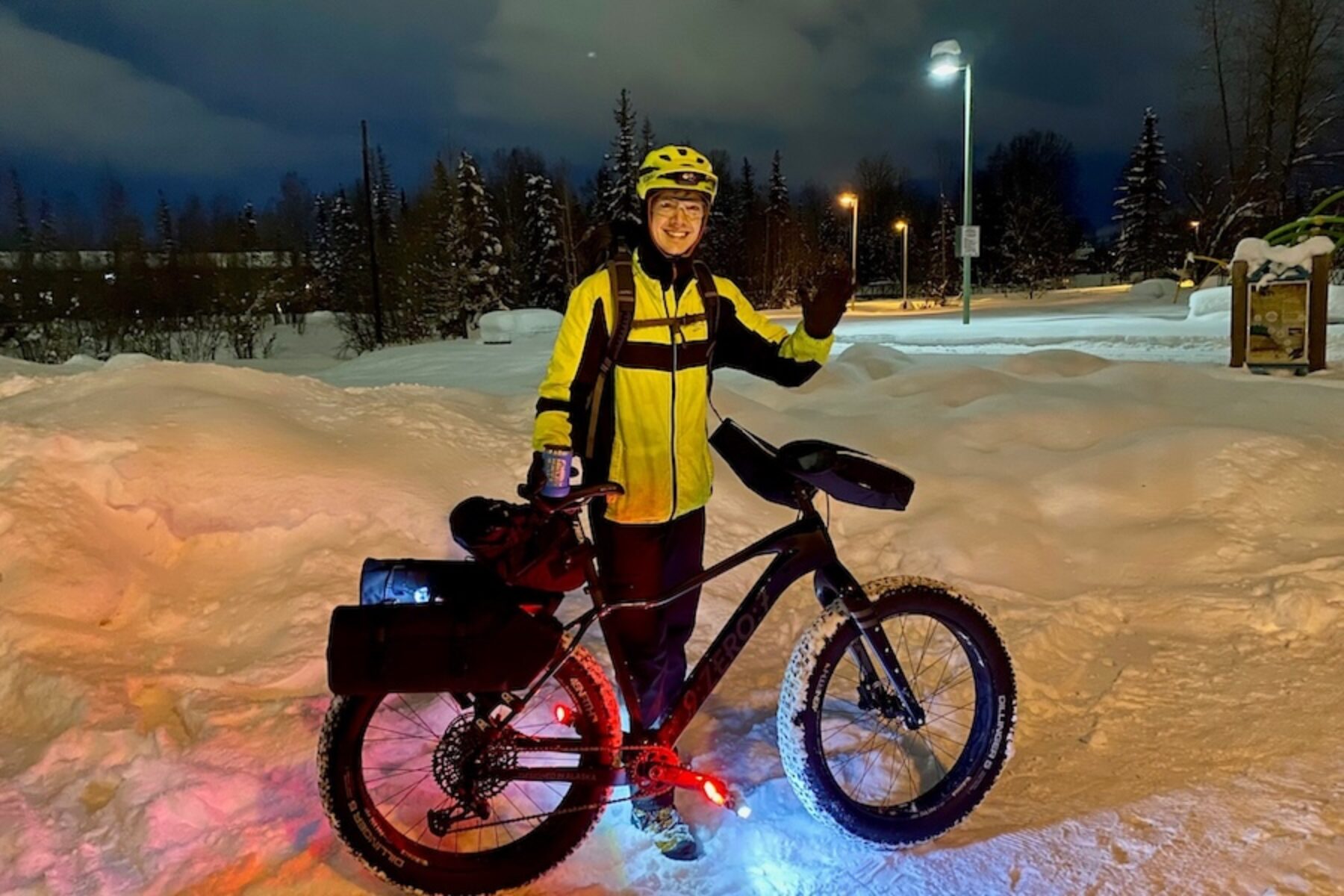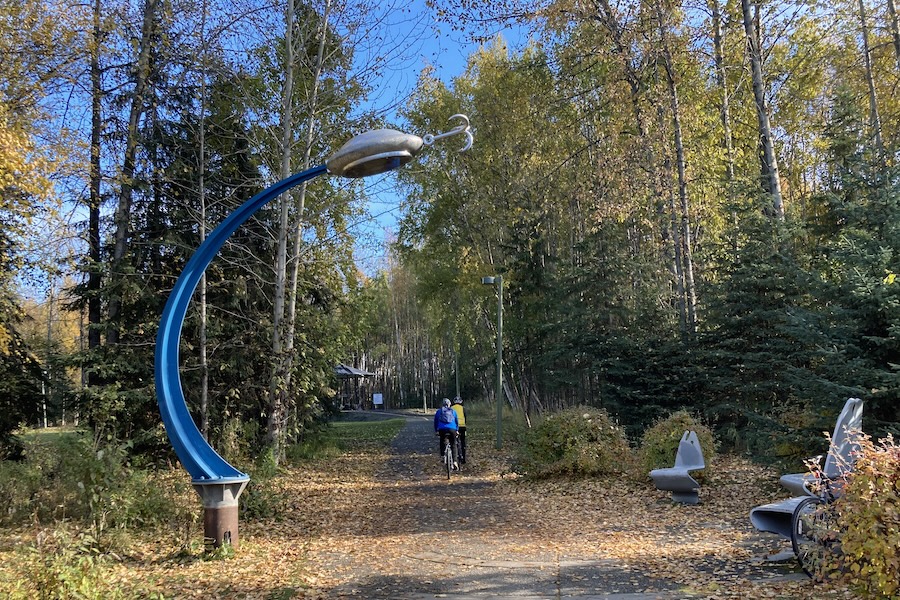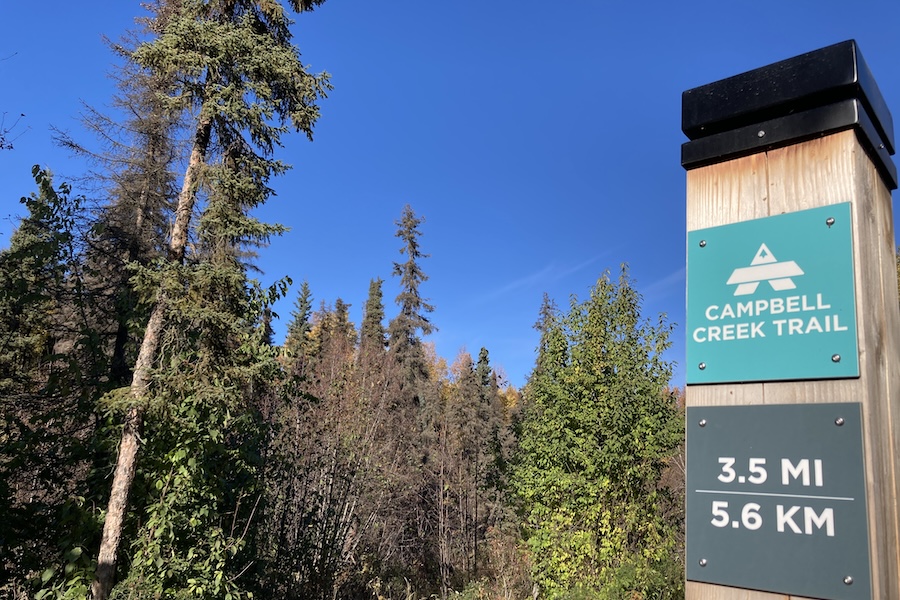Alaska’s Campbell Creek Trail

Trail of the Month: March 2024
Alaska’s short, sunlit summers and its long, dark winters are no match for the Campbell Creek Trail. On the contrary, the trail is a year-round highlight—sun or snow. The 7.5-mile gem follows Campbell Creek from the Chugach Mountain foothills through Anchorage’s urban center, ending at Campbell Lake on its journey southwest toward Cook Inlet.
“People are very health conscious, they’re always trying to move and because we have such an incredible trail system, it makes it really easy.”
—Kathy Dunn, Vice President of Communications, Visit Anchorage

The trail is one of four in the city that make up the paved, 32-mile Moose Loop—a connected trail system that takes the shape of the iconic Alaskan animal when viewed on a map—that’s being spearheaded by the Anchorage Park Foundation. As part of this active transportation network, the Campbell Creek Trail offers key connections for commuters, such as links to the region’s top universities—the University of Alaska Anchorage and Alaska Pacific University—and to the city’s UMED district, home to the Providence Alaska Medical Center. And to make it even more visible to the community and easier to navigate, the Moose Loop project was recently awarded $15,000 from Rails to Trails Conservancy’s Trail Grants program for the addition of wayfinding signage.
“It’s on the south side of town and is part of the Moose Loop, so it gets you all around town,” said Tanya Hickok, a senior park planner for the Municipality of Anchorage. “It’s well used and well loved.”
Related: These 2023 Trail Grants Are Activating Trails and Trail Networks Across the US (TrailBlog)
Campbell Creek’s History

Prior to Anchorage becoming Alaska’s largest city, containing nearly 40 percent of the state’s population, it was home to the Dena’ina people, who lived and subsisted off the land from time immemorial. The Dena’ina people know Campbell Creek as Qin Cheghitnu or “Crying Ridge Creek,” which may imply that the creek was a sacred place of mourning, according to Cherie Northon, who wrote A Cultural and Historical Geography of Campbell Creek, Anchorage, Alaska.
“For over a thousand years, the Dena’ina of Upper Cook Inlet have traditionally harvested salmon and followed the creek to the headwaters of Qin Cheghitnu in the mountains, where they were able to honor their ancestors and reaffirm their connection to these sacred lands,” explained Aaron Leggett, president of the Native Village of Eklutna, who is also a senior curator of Alaskan history and Indigenous cultures at the Anchorage Museum, located about 4 miles north of the trail.
Leggett is partnering with the Anchorage Park Foundation on a place-naming project to add signage along the Moose Loop trails, including the Campbell Creek Trail. Over the next five years, the project will add 32 signs with the original Indigenous names of landmarks along the trails that currently carry the names given to them by colonizers and explorers such as Capt. James Cook and Capt. George Vancouver.
A Growing Greenbelt

Diana Rhoades of the Anchorage Park Foundation noted that there’s also one last roadway crossing needed to complete the trail—a safer connection over busy Lake Otis Parkway—that’s in the works. But even as it crosses the city, much of the Campbell Creek Trail is buffered by trees, providing a tucked-into-nature feeling. Along the way, it provides access to numerous recreational amenities, including major parks such as Far North Bicentennial Park, the Alaska Botanical Garden and Taku Lake Park, as well as smaller facilities like dog parks.
“One of the cool things about the Campbell Creek Trail is that you can do a brewery tour using the trail, which makes it really exciting, and there’s also Taku Lake right on it so you can go fishing and boating—there’s a wealth of activities,” enthused Rhoades.
Hickok remembers using the Campbell Creek Trail as early as the 1990s when she was just in high school. Its development kicked off in the early 1980s when the 97th Congress passed funding for the creation of a greenbelt surrounding Campbell Creek.
“The municipality is granted bonds by voters,” said Hickok. “Every year, there’s a bond in place, and if they get approved, then those bonds go toward the projects that they’re allocated for. The Campbell Creek Trail has received long-standing support through these bonds.”

So far, the trail has received more than $5.3 million through bonds continuously approved by the public since the mid-2000s. Over the years, a majority of the money has gone to rehabilitation projects such as restoring streambanks, repairing damaged sections of trail, supporting bridge replacements and making minor trail realignments. The Campbell Creek Trail is now in Phase 5B of its overarching bond plan, which will see another minor realignment and bridge reconstruction.
While the bond projects don’t include federal funding, other projects, such as the pedestrian bridge over Lake Otis Parkway, are being funded by Alaska’s Department of Transportation with the City of Anchorage matching the funds at 9%. Hickok said the approved bonds and multi-municipal partnerships speak to the importance that the trail system has to the people of Anchorage.
A Community Asset

In addition to the connections it makes with the Lanie Fleischer Chester Creek Trail, Tony Knowles Coastal Trail and Ship Creek Trail to complete the Moose Loop, the Campbell Creek Trail has also been a boon for children and their parents by providing access to more than a dozen elementary schools surrounding the route. And this fall, the trail is set to see another benefit for Anchorage’s youth: a new skate park at Taku Lake—a project that received investment from the legendary skater Tony Hawk and the Alaskan rock band “Portugal. The Man.”
In the summer, Anchorage families can also enjoy floating down Campbell Creek on innertubes, kayaks and other paddle boats in addition to the cycling, skating, walking and other activities that the paralleling trail offers. Along the way, glimpses of beaver, fish, birds and the occasional moose are possible, too.

Rhoades says the Campbell Creek Trail provides access to the area’s best known creek for salmon fishing. Thousands of chumps, pinks and sockeye spawn yearly, but one can also find rainbow trout and Dolly Varden.
Beyond summer, the trail is packed with activity during the colder months, too. “In the wintertime, you get a lot of people using it when they’re cross-country skiing or fat-tire biking,” said Kathy Dunn, vice president of communications for Visit Anchorage, who happens to live just a short drive away from a trailhead. Dunn adds that because Anchorage is such a big biking town, the trail is an integral part of the community.
“People in Anchorage, they’re always trying to get a workout in before work or after work,” Dunn said. “People are very health conscious, they’re always trying to move and because we have such an incredible trail system, it makes it really easy.”

Related Links
Trail Facts
Name: Campbell Creek Trail
Trail website: Anchorage Parks and Recreation
Length: 7.5 miles
County: Anchorage
Start point/end point: E. Tudor Road and Elmore Road (Anchorage); Dimond Blvd. and Victor Road (Anchorage)
Surface type: Asphalt
Grade: The trail has an elevation gain of 469 feet over 7.5 miles, with a grade of 1.2%.
Uses: Walking, bicycling, inline skating, fishing, cross-country skiing; wheelchair accessible
Difficulty: With a paved surface and relatively level grade, the trail is considered an easy experience.
Getting there: The northernmost trailhead is 6.5 miles east of the Ted Stevens Anchorage International Airport (5000 W. International Airport Road, Anchorage).
Travelers can also arrive into Anchorage via the Alaska Railroad; its passenger depot (411 West First Ave.) is located about 5 miles from the Campbell Creek Trail.
Access and parking: Parking is available at many of Anchorage’s parks and recreational facilities located along the trail; here are a few options from northeast to southwest:
- Chuck Albrecht Softball Complex (4781 Elmore Road)
- Campbell Creek Park (Folker St. and E. 46th Ave.)
- Waldron Park (Shelikof St. and Chirikof Ct.)
- Foxtree Park (569 E. Dowling Road)
- Taku Lake Park (100 E. 76th Ave.)
- Emerald Hills Park (2651 W. Dimond Blvd.)
To navigate the area with an interactive GIS map, and to see more photos, user reviews and ratings, plus loads of other trip-planning information, visit TrailLink.com, RTC’s free trail-finder website.
Rentals: A number of bike shops in Anchorage offer rentals; options near the Campbell Creek Trail include:
- Trek Bicycle Store Anchorage (530 East Benson Blvd.; phone: 907.743.6000)
- Alaska Outdoor Gear Rental (540 W. Potter Drive; phone: 907.830.0232)
- Downtown Bicycle Rental (333 W. Fourth Ave.; phone: 907.279.3334)
- Pablo’s Bicycle Rentals (415 L St.; phone: 907.277.2453); open seasonally May through September

Donate
Everyone deserves access to safe ways to walk, bike, and be active outdoors.